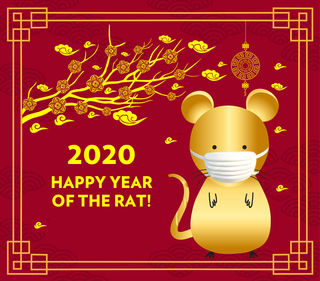Creativity
Happy Chinese New Year to Innovators: Year of the Rat
Part 1: What can the ancient art of feng shui teach us about innovation?
Posted January 31, 2020 Reviewed by Lybi Ma

Last week, the Chinese New Year arrived, the Year of the Rat. That got me thinking: With a blog titled the Tao of Innovation, maybe I should put a bit more tao into it.
When you think of Taoism, a couple of practices usually come to mind, acupuncture and feng shui. Acupuncture is better known in the west. My first experience with it was amusing. In college, I helped set up our school’s first Tai Chi Ch’uan class. Since this was a very serious science school, I decided we needed a serious scientist to teach us. I found a local teacher named Dr. Daniel Lee, who was an actual rocket scientist at JPL, and also, remarkably, Bruce Lee’s #4 student. I absolutely loved the art of tai chi, especially by this brilliant yet humble teacher, and studied the form diligently.
After a couple of years, I was invited to a martial arts summer camp to deepen my study, and at this camp, I slipped and fell down a flight of stairs. Fortunately, the years of martial arts training helped me to avoid breaking any bones, but I did sprain both ankles. Immediately, a number of classmates came up, armed with portable needle kits, and they all announced that they were acupuncturists. As a scientist, this was a perfect opportunity to run an experiment. I immediately said, “Great! Please fix one ankle!” The doctors surrounding me were kind of stunned by my request, but after I explained why, they were eager to take the challenge.
Both ankles were pretty much equally sprained, and they picked one and stuck several tiny needles into the ankle, leg, and arm. But only on one side of my body. I felt some electrical charge, and then rested to see how I’d feel the next day. Amazingly, the treated ankle was fine the next day, but the untreated ankle required crutches for two weeks. So I can testify that acupuncture actually works. Over the years, I’ve sought out the most talented acupuncturists, and have seen dramatic results with certain ailments for both myself and friends I’ve referred.
However, every single time I have asked the acupuncturist why acupuncture works, the answer has been wholly unsatisfying. They know how it works, but the why is essentially a mystery to western science. To this day, there is no way to measure a “meridian” of life energy flow, or scientifically detect the difference between the “five energies” of water, fire, air, earth, and metal. It just works.
What is feng shui?
Let’s talk about the Chinese art of feng shui, aka geomancy, which is about how the five energies affect your house, your business, and your fate. I remember a TV show a decade ago that used this joke:
Question: What does feng shui translate to?
Answer: Roughly translated, it means some people will believe anything.
The requirement to suspend your disbelief with feng shui is an order of magnitude greater than with acupuncture. Really, it’s kind of wacky. Why would putting a mirror in a certain corner of your house make any difference in your life? But then, if you think about it, why would putting a little needle in your elbow cure your cold? Perhaps we can think of feng shui as acupuncture at a different level?
But rather than arguing theory, I think what’s more important is empirical evidence. Does this crazy stuff actually work?
I think the most scientific analysis of the accuracy of feng shui, free of the confirmation bias that will happen when putting a mirror in the corner of your house, can be found in the world of stock market predictions. There is a Hong Kong-based asset management company called CLSA, with over USD $4 billion under management, which publishes the CLSA Feng Shui Index. Using nothing but feng shui analysis, they plot the predicted behavior of the market for the next 12 months and have been remarkably accurate in their predictions.
Consider this chart of prediction vs. market data from 2015. This feng shui stuff does manage to capture the general flow of the financial energy of the Hang Seng market.
Now, I’d like to point out that when CLSA analysts are interviewed by US-based financial news networks, you can see the newscasters struggling not to smirk. But the fact is: This is one of the top-rated asset management firms in the world, that has consistently topped the charts in terms of ROI using this approach, combined with modern stock forecasting models and programs. Also, it should be noted that early feng shui masters approached the practice somewhat diligently and with a scientific view, as the penalty for prediction failure was likely a beheading by the emperor of China.
One detour: What do the feng shui experts say will happen this year? For the Hang Seng index, you can go to CLSA’s website and read their predictions: clsa.com.
However, if we dig a little deeper, we will find that feng shui analysis uses the five energies cycling against the 12 animals of the zodiac. As a result, there are two cyclical patterns to observe, a 12-year pattern and a 60-year pattern (5x12). Regarding the 12-year cycle, most feng shui analysts will note that the bond market signaled recession on August 14, 2019, when the 10-year Treasury Bond yield fell below the yield of the two-year bond. It marks the first time since 2007 that the curves have inverted; interestingly, this was the year of the Pig just as last year was, 12 years earlier. This signal flashed that year and we subsequently went into the Great Recession in 2008, a Rat year. Because the inverted bond yield signaled again last year, it foretells of another recession coming late this year, just in time for the elections. We’ll see if they’re right in a year.
What does feng shui have to do with innovation?
Whether or not you believe in acupuncture and feng shui, this line of thinking is useful for stimulating innovative thought. The Year of the Metal Rat is the initiating year of this 60-year cosmic cycle. Instead of limiting our thinking to the tech trends of the coming year, let’s instead think about the next sixty.
The archetypal image of the Celestial Rat is a very small but persistent animal slowly gnawing its way into a new era. Something small that becomes something massive. If you go back 60 years to the last Year of the Metal Rat, we’d rewind to the 1960s, a time when two little inventions drastically transformed society. First, the birth control pill launched the sexual revolution, and second, the microchip launched the computer revolution.
Feng shui leads us to think about things this way: What might the next 60-year cycle bring in terms of innovations that could transform our world?
Over the next few years, the Metal energy will be especially pronounced. In traditional Chinese feng shui theory, metal carries the image of a knife or a sword. Or of an acupuncture needle that changes the internal configuration of life energies in the body. But in modern times, Metal energy correlates to computing. Perhaps, three emerging computational shifts will drive the next 60-year cycle: Blockchains, artificial intelligence, and quantum computing.
To keep this article from getting too technically obtuse, I'll include some feng shui generated tech trends in Part 2 of this series.
The Feng Shui of Innovation
Returning to the metaphor of feng shui, these trends have meaning over both the 12- and 60-year timeframes. AI and blockchains will be built out over the next few years, and then be fully woven into the fabric of human computing over the following decade. Quantum computing will require the next several to a dozen years to develop a general-purpose computing infrastructure, and then it will require the balance of the 60-year cycle to fully express itself through society. By 2050, the world will be quite different from what it looks like today.
These new technologies will drastically change our lives. If they are used wisely, they will improve the way we live, learn, love, connect, work, and do business. If misused, they can create problems that could dwarf any issue we can imagine today. But what’s most compelling is that these new technologies have the potential to bring meaning to our lives in ways we’ve never seen before.
Over the last five decades, our society has experienced what I consider “normal” exponential change. As Moore’s Law dictates, computers have steadily become roughly twice as powerful every 18 months. The predictability of the decline in the cost-to-performance ratio of computing and communications technology has allowed us time to adapt in a manageable way. But what’s coming won’t be just another bout of predictable and continuous change that we can understand and prepare for. What is coming is discontinuous change: a massive phase transition for humanity is coming.
This is because quantum computing technology is fundamentally different from today’s transistor-based computers. Quantum computers can tackle complex problems that are currently impossible today, or that would take an impossibly long time to solve. Think 100,000,000 times faster for logistics optimization, or 100,000,000 times faster designing new drugs, or 100,000,000 times faster detecting a dangerous package in transit. And this change doesn’t come every decade or every year. It happens the minute some physicist comes up with the idea for how to perfect a general-purpose quantum computer. Discontinuous innovation is something that happens overnight.
This is not just another new year to celebrate. It’s the birth of a new era, the Year of the Metal Rat kicks off a 60-year cycle of technological revolution and societal evolution that will offer both great opportunities and significant challenges. Resisting change will only set you and your company behind. True leadership in the 21st century will require each of us to courageously jump headfirst into whatever the future will bring.
Go to Part 2 of this post.





